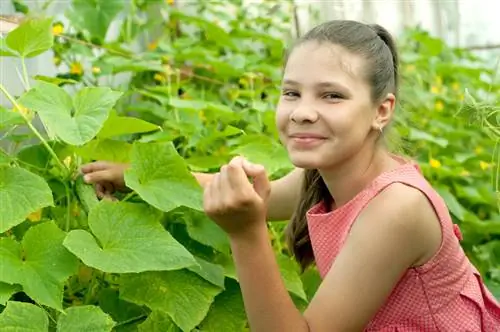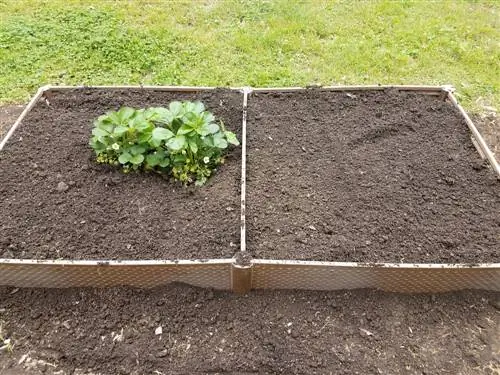- Author admin [email protected].
- Public 2023-12-16 16:46.
- Last modified 2025-01-23 11:20.
Rose propagation is a very special chapter in itself, because not every type and variety of rose can be propagated in a simple vegetative way. This can be done quite easily with the various types of wild roses as well as with climbing roses and some shrub roses. Many bedding and noble roses, on the other hand, can only be obtained by grafting or grafting, while propagation from cuttings is extremely laborious and rarely successful. Unless you do the grafting yourself or want to have it done by a professional, the roses you propagate yourself are always rootless.

How to propagate roses?
Roses can be propagated by cuttings, cuttings, root shoots or seeds. Shoots 15-20 cm long are suitable for cuttings; cuttings are 20-30 cm long and woody. Root shoots can be transplanted directly while seeds are stratified and sown in potting soil.
Propagation by cuttings
One of the easier ways to propagate roses is by cuttings, which are best cut in August. Cut off two more shoots for each desired cutting, as experience shows that the success rate is around 30 percent.
- It is best to use shoots that have just bloomed and are about 15 to 20 centimeters long.
- These should have at least five eyes.
- Make the cut at a slight angle,
- this makes it easier for the cutting to absorb water later.
- Remove all but the top pair of leaves.
- This keeps the evaporation rate as low as possible.
- Choose sufficiently deep plant pots,
- which you fill with potting soil or sandy garden soil.
- Plant the cuttings in there,
- water them well
- and place it in a warm and bright place.
- However, avoid direct sunlight.
- Now cut off the top of a plastic bottle
- and put it over the cutting as a mini greenhouse.
- Alternatively, you can also use a disposable glass or something similar.
The rooted young roses can finally be transplanted to their destination in the spring of the following year.
Propagate roses through cuttings
Another option for vegetative rose propagation is through cuttings, which - in contrast to cuttings - are not cut in summer, but in late autumn or winter. This is a completely woody rose shoot from which all leaves are removed. Cuttings should be between 20 and 30 centimeters long.
- Cut off a whole, woody rose shoot after the leaves have fallen
- and remove all side shoots with any leaves and flowers that may still be on them.
- Now take a box with a well-lockable lid,
- and fill it with wet sand.
- The cuttings are carefully packed in sand so that they do not dry out before planting.
- Store them in a cold but frost-free room until spring.
- As soon as it is warm enough in spring (around March), plant the cuttings in a sand-peat mixture.
- Alternatively, you can also use potting soil.
- The rooted cuttings can finally be planted at their final destination in the fall of the same year.
Using root shoots for propagation
Many roses, v. a. Climbing roses, propagate themselves through root shoots. Of course, you can also use these for propagation, but only with true-root rose varieties. Root shoots cannot be used with inoculated or grafted roses, as these do not come from the noble rose itself, but from its rootstock - although these are often more robust wild rose species. For this reason, you should always remove root shoots from grafted roses, otherwise the rootstock will gain the upper hand and will soon reject the graft. Otherwise, simply cut off the root shoots with a spade and lever them out of the ground using a digging shovel. These young plants can be transplanted immediately to the desired location.
Growing a rose bush from seeds
Wild roses as well as some shrub and noble roses can be propagated by seeds; after all, these types of roses often develop seed-containing rose hips - as long as you leave them and don't cut away the dead ones straight away. By the way, some rambler roses can also be reproduced in this way. Proceed as follows when propagating:
- Collect the ripe rose hips in autumn (these can be recognized by their rich red or orange color).
- Cut the fruit and remove the pulp and seeds.
- Soak the seeds and pulp in warm water for a few days
- and remove the pulp thoroughly.
- Before sowing, the rose seeds must be stratified, i.e. H. You can keep them in the fridge for at least four weeks.
- Pack the seeds in a can or jar with moist sand.
- The vegetable compartment is ideal for storage.
- The seeds are then sown in potting soil and covered with soil about a centimeter thick.
- First the seeds are kept cool and moist,
- the temperature can only rise slowly - just like in nature.
- The small seedlings with around four to six leaves are transplanted into individual pots.
Many noble and floribunda roses can only be obtained through refinement
Noble and floribunda roses in particular are propagated primarily through grafting. By the way, you can also grow roses yourself in this way - but you need to inoculate orGrafting requires a certain sensitivity. That's why we have explained these techniques for you in a separate article.
Tip
Be careful, not all types of roses can be propagated yourself! Many rose breeds, especially more recent ones, are under plant variety protection and if you propagate them you will be liable to prosecution because you are violating copyright.






